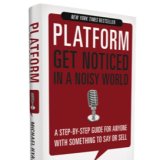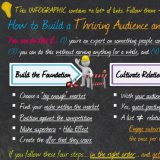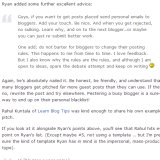
Do you ever run out of ideas, or feel that some of your best ones aren’t getting the attention they deserve?
There’s an easy solution: repurpose your existing content to create something brand new.
Repurposing content can be as simple as creating a downloadable version of a great blog post, or as complex as turning a fact-filled PowerPoint presentation into a slick infographic. The transformation that your content undergoes could be big or small: what matters is that you get to create something new without starting over from scratch.
You might see it as a form of recycling – or even of rediscovery. Sometimes, repurposing content allows you and your readers to see it in a whole new way.
I’ve never met a content creator who had all the time they wanted to produce blog posts, social media updates, podcasts, videos, infographics … there just aren’t enough hours in the day.
Whether you’re part of a dedicated content marketing team, or fitting it in around the rest of your job, you almost certainly don’t have enough hours in the day to get everything done. And while it’s obviously important to create fresh, interesting content, if you’re trying to come up with a brand new idea for every single item you create, you’re wasting time.
Repurposing content allows you to:
Of course, despite all these benefits, there are probably valid reasons why you’re not already engaged in content repurposing. Maybe you don’t know where to begin, or you’re worried that it’s going to end up taking more effort than simply creating something new.
I’m going to take you through 12 different ways to repurpose your content, starting with simple repackaging and moving on to some more complex methods.
Before we get on to that, though, there’s one key change you may need to make if you’ll be repurposing content: you need to have a content calendar that covers at least the next two or three months.
If you’re constantly creating and publishing content with a very fast turn-around, you may struggle to find opportunities to repurpose it effectively. It’s usually a good idea to allow a bit of time between the original piece of content and the repurposed one, rather than bringing them out on top of one another … but you don’t want to let years go by, or the content may no longer be so relevant.
If you want some help creating an editorial calendar, check out my post How to Create an Editorial Calendar Using Trello (and Why You Need One).
The simplest way to repurpose content is to simply “repackage” that content in a new form.

If you’ve got an in-depth blog post that’s performed well, try creating a downloadable version (like a mini-ebook). You could use this to encourage sign-ups to your newsletter, or you could publish it on a site like Scribd or Amazon.
Example:
Johnny B Truant turned a long blog post, The universe doesn’t give a flying fuck about you, into a mini-ebook on Amazon.

Any audio content you have, whether it’s a short, regular podcast or an in-depth seminar, can be transcribed and turned into a blog post (or a downloadable file). Some of your audience may prefer to read rather than listen.
Example:
Joanna Penn does this with her podcasts, such as How Audiobook Narration And Production Works. (She also gives an audio-only option for video podcasts.)

Do you ever give presentations at industry events, or to your clients? If these would be useful to your audience, you can put them up on SlideShare (think of it as a YouTube for presentations, infographics, and so on). You can embed your SlideShare presentations on your website, too.
Example:
Brand Nunnally’s SlideShare Choice … The Gateway Drug to Engagement was originally a presentation at South by South West interactive, 2014.

Blog posts have a huge number of benefits, but one key drawback: they get buried in the archives relatively quickly. If you have some great posts that have disappeared off the front page, consider transforming them into featured articles and linking to them prominently in your navigation.
Example:
We did this here at Zen Optimise with some of our best blog posts, creating three sets of nine guides for different groups within our audience: career-minded individuals, small and medium businesses, and large companies.
Tip:
If you repurpose content in this way, I recommend adding a canonical tag on the original blog posts to point to your new articles: this avoids duplicate content issues. For instance, in our post 21 Grab-and-Go Ideas for Blog Posts, we have the tag
<link rel="canonical" href="https://zenoptimise.com/articles/21-blog-post-ideas" />
Often, content repurposing means bringing together several pieces of content that were originally separate. They might have been intended as a series (e.g. of blog posts) or they might simply be top picks.

Do you curate interesting content through your Twitter, Facebook, or Pinterest account, sharing links to blog posts, infographics, etc that you know your audience will find useful and interesting? If so, don’t let the hard work of finding that content go to waste. Bring the links together in a blog post or even a Google+ update (you can find out how to use formatting in Google+ here).
Example:
The links in our Weekly Optimiser are usually taken from resources I’ve shared on social media sites during the week. I don’t use every single link, but select the very best ones. To make the selection process easier, and to give consistency for our readers, we always have one top pick, plus three links in each category of SEO, Content Marketing and Social Media.

Your social network updates might feel pretty ephemeral, but there’s no reason you can’t turn them into something that’s likely to get longer-lasting attention. Try compiling your most retweeted or most favourite tweets from the past month, for instance.
Example:
Rae Hoffman brought together her live tweets from an SMX Advanced session with Matt Cutts, and added extra content plus updates within the post. It’s a great example of how tweets that were very much tied to a particular time and location can be given a longer life.

If you’ve written a number of blog posts in a linked series, or simply have a lot of content on a particular topic, how about publishing an ebook of your posts … or even a print book? Some bloggers do this on their own, others work with publishing houses. Although you might think readers wouldn’t pay for content they can get freely online, don’t underestimate the convenience factor (and the added authority) of having the material organised into a book.
Example:
Michael Hyatt’s book Platform: Get Noticed in a Noisy World includes quite a bit of content repurposed from his blog.

If you have an in-depth blog post, or several long posts, could you split them into smaller chunks and turn them into an autoresponder email series or a regular newsletter? You could turn one blog post into several emails, or several posts into one email, depending on what sort of content you’re sending.
Example:
We use links from our Weekly Optimisers in our monthly newsletter (each Weekly Optimiser has 10 links, and the monthly newsletter also has 10, so we’re pretty choosy about which we keep!)
Repackaging and compiling content are both relatively straightforward forms of repurposing. You can go further, though, and transform one type of content into something quite different.

For some reason, this seems to be one of the first types of “repurposing” that many content marketers think of. It can certainly be valuable, but do ensure the posts you’re using can be successfully translated into graphical form. Lots of statistics or facts and short quotations work well.
Example:
Derek Halpern from Social Triggers has an infographic, How to Write the Perfect Blog Post, that draws on material from several blog posts (quoted and linked to in the infographic).

While infographics are popular, they may leave readers uncertain about how best to take action – and they’re also not easy to print out and use for reference. You can help by creating a downloadable checklist that summarises the key action points from the infographic.
Example:
Demian Farnworth’s highly designed infographic on Copyblogger, 11 Essential Ingredients Every Blog Post Needs, has a handy downloadable checklist for blog writers to use while producing their post.

If you’re selling a book or course, a great way to promote it is with a webinar that summarises the key points or process. You’ll obviously need to vastly reduce the amount of content, creating what’s essentially an outline (though make sure it includes valuable, actionable advice too, or attendees will be disappointed).
Example:
When Danny Iny markets his Audience Business Masterclass program, his promotional webinars explain the ABM process, just in much less detail. There’s even a non-webinar version as a downloadable .pdf, linked to here.

As I mentioned before, repurposing content doesn’t just include content that you’ve created yourself. Readers’ comments (or tweets, etc) can often include helpful tips or new insights that you want to share more prominently with your audience – like blog posts, comments soon stop being seen.
Example:
Our Head of Content Ali Luke is also editor of DailyBlogTips. In Great Guest Post Pitching Advice from Two DailyBlogTips Readers, she picked a couple of in-depth readers’ comments and crafted the post around them.
As you can see, there are a huge number of ways to repurpose content. Pick one of the transformations to try this week, then start looking for ways to create compilations of some of your content that might otherwise not get the attention it deserves.
Drop a comment below to tell us what you’re going to try – or to share any great examples of content repurposing that you’ve come across.
Designed, Built and Optimised by Joe the SEO
© Tribe SEO is a registered UK Company (# 07455058). Privacy Policy and Terms.
This site is protected by reCAPTCHA and the Google Privacy Policy and Terms of Service apply.